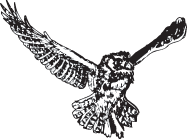

Eastern Screech Owl
(Otus asio)
Screech Owls have been likened to "feathered wildcats." They are the smallest "eared" owl east of the Rocky Mountains. Flight is rapid with a steady wing beat. The Screech Owl rarely glides for more than a few seconds at a time and very seldom hovers. The Screech Owl is extremely maneuverable as it plucks moths and other flying insects out of midair.
The habitat of the Screech Owl is deciduous broad-leaved forest, open woodlands, orchards, parks and gardens, and wooded creek bottoms. The Eastern Screech Owl occurs in two highly distinct color morphs, bright reddish-brown and dull-gray. Studies have shown that more gray-phase birds are found in the North and more red-phase birds are found in the South.


The Screech Owl's ear openings are small and symmetrical. Hearing is superb and a vital factor in pinpointing the location of prey. Its symmetrical ears and yellow eyes work together to triangulate on prey in all kinds of weather conditions. The favored prey are small rodents followed by large quantities of insects. Their diet is quite varied and many include birds as large as blue jays, morning doves, woodpeckers and starlings.
A tree cavity is often used to roost in during daylight hours or the owl tries to camouflage itself as a broken branch by elongating its body, erecting its feather tufts and closing its eyes to mere slits.
Screech Owls are one of the more nocturnal owls, completing its hunting activity the first four hours of night. Screech Owls communicate with squeals, bill-snapping, scolding, hoots, whistles, high-pitched cackles and their feather tufts. The Eastern Screech Owl hunts in the same habitat as Great Horned Owls, Red-tailed Hawks, Red-shouldered Hawks and Cooper's Hawks -- all of which will prey upon the Eastern Screech Owl if given the opportunity.
In late March or early April screech-owls lay four to six white eggs. The female incubates the eggs which all hatch the same day, synchronously. Eastern Screech Owls are second only to robins as the most frequently killed by vehicles (road kills). As a result of hard pesticide poisoning of the environment, the species has also suffered from eggshell thinning.